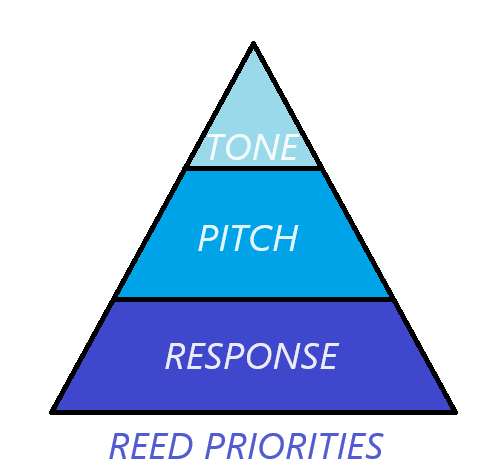Reed Quality
What makes a reed good or bad?
A playable reed has predictable response, stable pitch. Any reed that is not predictable should not be used in rehearsal with any ensemble. A good reed has easy response, accurate pitch, and acceptable tone quality.
Response is how the reed responds when you try to start the sound. The better the response is, the easier it is to start notes in all registers and at all dynamic levels.
Pitch can be another word for intonation. A reed with stable pitch is one that allows you to play in tune without making unexpected adjustments in voicing, support, or embouchure.
A reed with good tone quality is hard to describe because we all have our own ideas about what makes a good tone on the bassoon. Some people prefer a vibrant and colorful sound with lots of overtones while others prefer a sound that blends more with other instruments and has fewer overtones. A good tone quality is basically whatever you like in a sound.

The fundamental and most important quality of a good reed is good response. Your top priority is to play your notes at the right time and right dynamic. If you have to use all of your energy and concentration to get the required response you won’t have anything left to think about playing in tune.
The next highest priority of a good reed is making it possible, or even easy, to play your notes in tune. If the reed is too hard, too narrow, and/or too short, it will be pitched high. This will make your notes sharp no matter how much you try to adjust. If the reed is too soft, too long, or too wide, it will be pitched low. This will make your notes flat no matter how much you try to support the sound and voice the notes higher. If you have to put all of your energy and concentration into playing in tune, you won’t have anything left to make music.
The final priority, and it is really icing on the cake, is a pleasing tone quality. This means you can make the quality of sound you want regardless of the register and/or dynamic.
A good reed allows you to play the way you want with the tone and musical expression you desire. A bad reed will make it a struggle to play the way you want.
A few things that can cause a reed to be “bad” include:
- A leak in the blade or the tube,
- A crack or chip in the blade,
- Splinters inside the tube,
- Uneven blades,
- Blades that are uneven, too thick, or too thin.
Some of these problems can be addressed to improve the reed’s performance but others cannot. See chapter 88 Tools for Simple Adjustments and chapter 89 Simple Reed Adjustments for more information.

Feedback/Errata